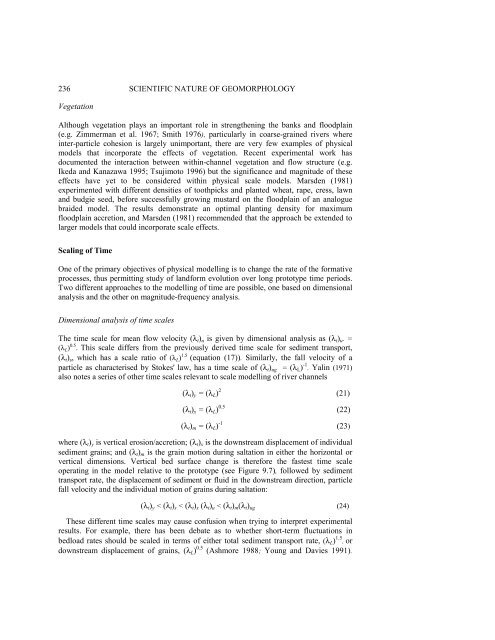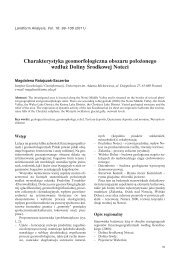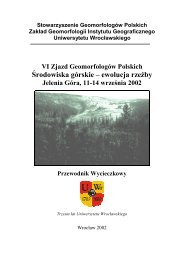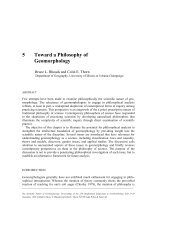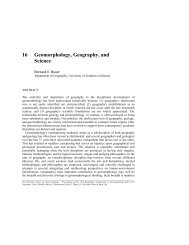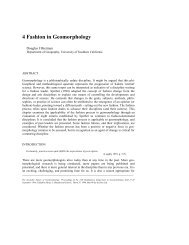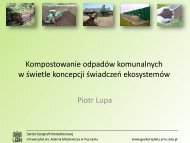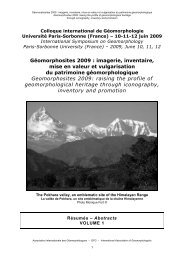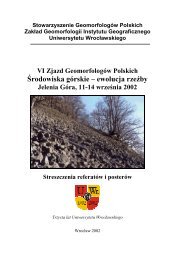Physical Modelling in Fluvial Geomorphology
Physical Modelling in Fluvial Geomorphology
Physical Modelling in Fluvial Geomorphology
Create successful ePaper yourself
Turn your PDF publications into a flip-book with our unique Google optimized e-Paper software.
236 SCIENTIFIC NATURE OF GEOMORPHOLOGY<br />
Vegetation<br />
Although vegetation plays an important role <strong>in</strong> strengthen<strong>in</strong>g the banks and floodpla<strong>in</strong><br />
(e.g. Zimmerman et al. 1967; Smith 1976), particularly <strong>in</strong> coarse-gra<strong>in</strong>ed rivers where<br />
<strong>in</strong>ter-particle cohesion is largely unimportant, there are very few examples of physical<br />
models that <strong>in</strong>corporate the effects of vegetation. Recent experimental work has<br />
documented the <strong>in</strong>teraction between with<strong>in</strong>-channel vegetation and flow structure (e.g.<br />
Ikeda and Kanazawa 1995; Tsujimoto 1996) but the significance and magnitude of these<br />
effects have yet to be considered with<strong>in</strong> physical scale models. Marsden (1981)<br />
experimented with different densities of toothpicks and planted wheat, rape, cress, lawn<br />
and budgie seed, before successfully grow<strong>in</strong>g mustard on the floodpla<strong>in</strong> of an analogue<br />
braided model. The results demonstrate an optimal plant<strong>in</strong>g density for maximum<br />
floodpla<strong>in</strong> accretion, and Marsden (1981) recommended that the approach be extended to<br />
larger models that could <strong>in</strong>corporate scale effects.<br />
Scal<strong>in</strong>g of Time<br />
One of the primary objectives of physical modell<strong>in</strong>g is to change the rate of the formative<br />
processes, thus permitt<strong>in</strong>g study of landform evolution over long prototype time periods.<br />
Two different approaches to the modell<strong>in</strong>g of time are possible, one based on dimensional<br />
analysis and the other on magnitude-frequency analysis.<br />
Dimensional analysis of time scales<br />
The time scale for mean flow velocity (λt)u is given by dimensional analysis as (λt)u. =<br />
(λ L) 0.5 . This scale differs from the previously derived time scale for sediment transport,<br />
(λt)s, which has a scale ratio of (λ L) 1.5 (equation (17)). Similarly, the fall velocity of a<br />
particle as characterised by Stokes' law, has a time scale of (λt)ug = (λL) -1 . Yal<strong>in</strong> (1971)<br />
also notes a series of other time scales relevant to scale modell<strong>in</strong>g of river channels<br />
(λt)y = (λL) 2 (21)<br />
(λt)x = (λL) 0.5<br />
(22)<br />
(λt)m = (λL) -1 (23)<br />
where (λt)y is vertical erosion/accretion; (λt)x is the downstream displacement of <strong>in</strong>dividual<br />
sediment gra<strong>in</strong>s; and (λt)m is the gra<strong>in</strong> motion dur<strong>in</strong>g saltation <strong>in</strong> either the horizontal or<br />
vertical dimensions. Vertical bed surface change is therefore the fastest time scale<br />
operat<strong>in</strong>g <strong>in</strong> the model relative to the prototype (see Figure 9.7), followed by sediment<br />
transport rate, the displacement of sediment or fluid <strong>in</strong> the downstream direction, particle<br />
fall velocity and the <strong>in</strong>dividual motion of gra<strong>in</strong>s dur<strong>in</strong>g saltation:<br />
(λt)y < (λt)s < (λt)x (λt)u < (λt)m(λt)ug<br />
These different time scales may cause confusion when try<strong>in</strong>g to <strong>in</strong>terpret experimental<br />
results. For example, there has been debate as to whether short-term fluctuations <strong>in</strong><br />
bedload rates should be scaled <strong>in</strong> terms of either total sediment transport rate, (λL) 1.5 , or<br />
downstream displacement of gra<strong>in</strong>s, (λL) 0.5 (Ashmore 1988; Young and Davies 1991).<br />
(24)


